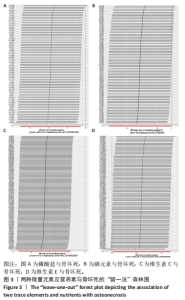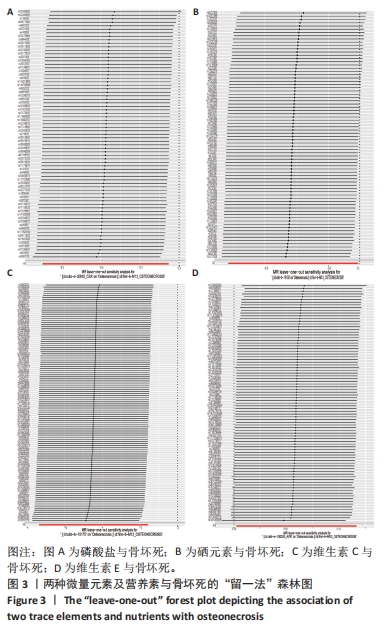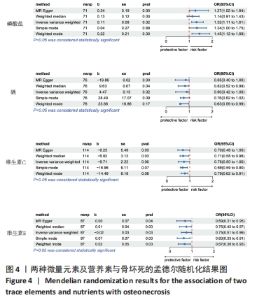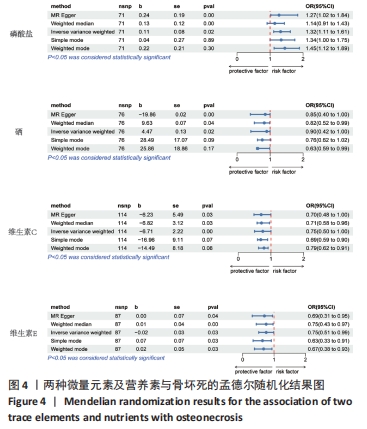Chinese Journal of Tissue Engineering Research ›› 2024, Vol. 28 ›› Issue (33): 5326-5332.doi: 10.12307/2024.654
Previous Articles Next Articles
Causal effects of serum trace elements and nutrients on osteonecrosis: a Mendelian randomization analysis
Liu Yi1, Liu Yuan1, Liu Jinbao1, 2, Li Nianhu2, Zhu Weiming3, Xu Bo1, 2
- 1Shandong University of Traditional Chinese Medicine, Jinan 250300, Shandong Province, China; 2Affiliated Hospital of Shandong University of Traditional Chinese Medicine, Jinan 250014, Shandong Province, China; 3Tianjin University of Traditional Chinese Medicine, Tianjin 300000, China
-
Received:2023-09-11Accepted:2023-10-20Online:2024-11-28Published:2024-01-30 -
Contact:Xu Bo, MD, Associate professor, Associate chief physician, Master’s supervisor, Shandong University of Traditional Chinese Medicine, Jinan 250300, Shandong Province, China; Affiliated Hospital of Shandong University of Traditional Chinese Medicine, Jinan 250014, Shandong Province, China -
About author:Liu Yi, Master, Shandong University of Traditional Chinese Medicine, Jinan 250300, Shandong Province, China -
Supported by:National Famous Traditional Chinese Medicine Expert Inheritance Studio Construction Project, No. [2022]75 (to LNH); Shandong Province Traditional Chinese Medicine Classic Formula Collaborative Innovation and Opening Project, No. 2019KFY17 (to XB); Shandong Province Traditional Chinese Medicine Technology Development Plan, No. 2019-0087 (to LJB)
CLC Number:
Cite this article
Liu Yi, Liu Yuan, Liu Jinbao, Li Nianhu, Zhu Weiming, Xu Bo. Causal effects of serum trace elements and nutrients on osteonecrosis: a Mendelian randomization analysis[J]. Chinese Journal of Tissue Engineering Research, 2024, 28(33): 5326-5332.
share this article
Add to citation manager EndNote|Reference Manager|ProCite|BibTeX|RefWorks

2.2 工具变量筛选结果 按照所设定标准筛选出符合3大假设的SNPs,使用PhenoScanner数据库移除可能影响结局的变量(rs10989692、rs1801133、rs1801131、rs7963801、rs1801239和rs7646054)。剩余工具变量的F值均> 10。在依据全基因组显著阈值P < 5×10-8为标准时,可用SNP数量较少,无法分析结果,故依据STROBE-MR研究规范及查阅文献将P值设定为P < 5×10-6。使用IVW方法估计磷酸盐、钙、铁、锌、硒、铜、镁、维生素B、维生素C、维生素E与骨坏死之间的关联,具体结果见表2。分别提取出71,118,84,337,76,33,13,92,114和87个SNP用于分析磷酸盐、钙、铁、锌、硒、铜、镁、维生素B、维生素C、维生素E与骨坏死的关系。"

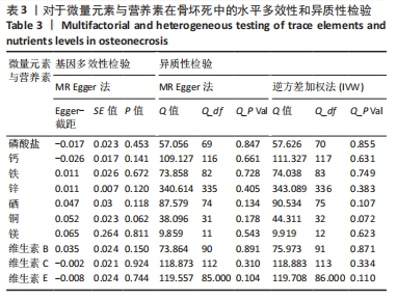
2.3 七种微量元素与骨坏死之间的因果效应 基因预测的7种微量元素对骨坏死疾病的影响如表2所示。其中,基因预测的磷酸盐血清水平较高与骨坏死的风险增加有关(OR=1.319,95%CI=1.112-1.614,P=0.018)。硒与骨坏死之间存在负向因果关系(OR=0.897,95%CI=0.416-0.999,P=0.022),说明硒可能是骨坏死的保护剂,而钙、铁、锌、铜、镁的IVW分析结果P > 0.05,说明与骨坏死之间不存在因果关系。 为了避免过度偏倚,进行了一系列敏感性分析,以测试MR分析的可靠性并检测潜在的水平多效性。如表3所示,MR-Egger的截距显示所有因果效应不存在水平多效性(P > 0.05)。"
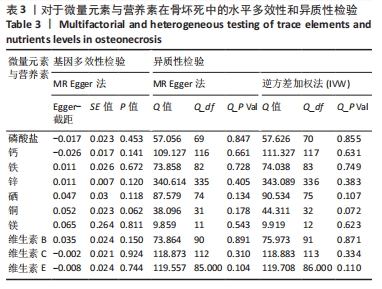
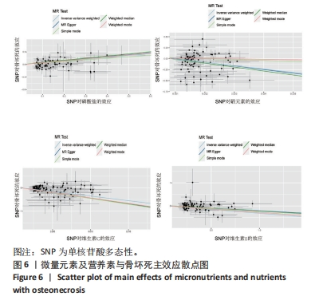
2.4 三种营养素与骨坏死之间的因果效应 基因预测的3种营养对骨坏死疾病的影响如表2所示。其中,维生素C(OR=0.751,95%CI=0.500-0.999,P=0.003)、维生素E(OR=0.750,95%CI=0.511-0.992,P=0.034)血清水平与骨坏死之间存在负向因果关系,说明维生素C和维生素E可能是骨坏死的保护剂,而维生素B的IVW分析结果P > 0.05,说明与骨坏死之间不存在因果关联。为了避免研究存在偏倚,同样进行敏感性分析,结果显示不存在水平多效性与异质性,如表3所示。说明MR分析结果稳健。图6显示了微量元素及营养素对骨坏死疾病风险因果预测的散点图。除了上述2种微量元素与2种营养素之外,其他5种微量元素及1种营养素与骨坏死之间不存在因果关系。"

| [1] JONES LC, HUNGERFORD DS. Osteonecrosis: etiology, diagnosis, and treatment. Curr Opin Rheumatol. 2004;16(4):443-449. [2] WU X, SUN W, TAN M. Noncoding RNAs in Steroid-Induced Osteonecrosis of the Femoral Head. Biomed Res Int. 2019;2019: 8140595. [3] WELDON D. The effects of corticosteroids on bone: osteonecrosis (avascular necrosis of the bone). Ann Allergy Asthma Immunol. 2009; 103(2):91-133. [4] LIU Y, MO L, LU H, et al. Dragon blood resin ameliorates steroid-induced osteonecrosis of femoral head through osteoclastic pathways. Front Cell Dev Biol. 2023;11:1202888. [5] CHAI JL, LU BW, DU HT, et al. Pyroptosis -related potential diagnostic biomarkers in steroid-induced osteonecrosis of the femoral head. BMC Musculoskelet Disord. 2023;24(1):609. [6] KONARSKI W, POBOŻY T, KONARSKA K, et al. Osteonecrosis Related to Steroid and Alcohol Use-An Update on Pathogenesis. Healthcare (Basel). 2023;11(13):1846. [7] YAMAMOTO T, IWAMOTO Y. Corticosteroids treatments and osteonecrosis of the femoral head. Fukuoka Igaku Zasshi. 2015;106(3):47-53. [8] WEINSTEIN RS. Glucocorticoid-induced osteonecrosis. Endocrine. 2012;41(2):183-190. [9] PAVELKA K. Osteonecrosis. Baillieres Best Pract Res Clin Rheumatol. 2000;14(2):399-414. [10] ZOFKOVÁ I, NEMCIKOVA P, MATUCHA P. Trace elements and bone health. Clin Chem Lab Med. 2013;51(8):1555-1561. [11] MILACHOWSKI KA. Investigation of ischaemic necrosis of the femoral head with trace elements. Int Orthop. 1988;12(4):323-330. [12] WANG L, ZHANG L, GAO M. Metabolic Disorders and Mineral Density of the Bone Tissue in the Early Pathogenesis of Osteonecrosis: Study on Rabbits with Steroid-Induced Osteonecrosis. Bull Exp Biol Med. 2021;170(6):724-728. [13] ZHENG LZ, WANG JL, XU JK, et al. Magnesium and vitamin C supplementation attenuates steroid-associated osteonecrosis in a rat model. Biomaterials. 2020;238:119828. [14] BOCANEGRA-PÉREZ MS, VICENTE-BARRERO M, SOSA-HENRÍQUEZ M, et al. Bone metabolism and clinical study of 44 patients with bisphosphonate-related osteonecrosis of the jaws. Med Oral Patol Oral Cir Bucal. 2012;17(6):e948-e955. [15] LORENZO-POUSO AI, PÉREZ-SAYÁNS M, GARCÍA A, et al. Vitamin D supplementation: Hypothetical effect on medication-related osteonecrosis of the jaw. Med Hypotheses. 2018;116:79-83. [16] YANG J, WU W, AMIER Y, et al. Causal relationship of genetically predicted circulating micronutrients levels with the risk of kidney stone disease: a Mendelian randomization study. Front Nutr. 2023;10: 1132597. [17] ZHU RC, LI FF, WU YQ, et al. Minimal effect of sleep on the risk of age-related macular degeneration: a Mendelian randomization study. Front Aging Neurosci. 2023;15:1159711. [18] DI RESTA C, PIPITONE GB, CARRERA P, et al. Current scenario of the genetic testing for rare neurological disorders exploiting next generation sequencing. Neural Regen Res. 2021;16(3):475-481 [19] ZHONG X, WANG L, XU L, et al. Disturbance of skin sensation and autism spectrum disorder: A bidirectional Mendelian randomization study. Brain Behav. 2023:e3238. doi: 10.1002/brb3.3238. [20] SKRIVANKOVA VW, RICHMOND RC, WOOLF BAR, et al. Strengthening the Reporting of Observational Studies in Epidemiology Using Mendelian Randomization: The STROBE-MR Statement. JAMA. 2021; 326(16):1614-1621. [21] 熊海安,刘晓玲,白植宝.上颌骨双磷酸盐相关性骨坏死临床观察[J].青海医药杂志,2020,50(5):74-76. [22] ENDO T, FUNAYAMA H, YAMAGUCHI K, et al. Basic studies on the mechanism, prevention, and treatment of osteonecrosis of the jaw induced by bisphosphonates. Yakugaku Zasshi. 2020;140(1):63-79. [23] MÜLLER WEG, ACKERMANN M, AL-NAWAS B, et al. Amplified morphogenetic and bone forming activity of amorphous versus crystalline calcium phosphate/polyphosphate. Acta Biomater. 2020; 118:233-247. [24] HUGHES EAB, ROBINSON TE, BASSETT DB, et al. Critical and diverse roles of phosphates in human bone formation. J Mater Chem B. 2019; 7(47):7460-7470. [25] PAZARÇEVIREN AE, TEZCANER A, KESKIN D, et al. Boron-doped Biphasic Hydroxyapatite/β-Tricalcium Phosphate for Bone Tissue Engineering. Biol Trace Elem Res. 2021;199(3):968-980. [26] THOMAS J, WORCH H, KRUPPKE B, et al. Contribution to understand the biomineralization of bones. J Bone Miner Metab. 2020;38(4):456-468. [27] GILBERT AK, NEWTON TD, HETTIARATCHI MH, et al. Reactive sulfur and selenium species in the regulation of bone homeostasis. Free Radic Biol Med. 2022;190:148-157. [28] WANG N, XIE D, WU J, et al. Selenium and bone health: a protocol for a systematic review and meta-analysis. BMJ Open. 2020;10(10):e036612. [29] 胡一新,石小兵,谢润琪,等.绝经后女性血清硒水平与骨质疏松骨密度和骨代谢指标相关性研究[J].中国骨质疏松杂志,2021, 27(9):1329-1332. [30] KURIBAYASHI M, FUJIOKA M, TAKAHASHI KA, et al. Vitamin E prevents steroid-induced osteonecrosis in rabbits. Acta Orthop. 2010;81(1): 154-160. [31] AGHAJANIAN P, HALL S, WONGWORAWAT MD, et al. The Roles and Mechanisms of Actions of Vitamin C in Bone: New Developments. J Bone Miner Res. 2015;30(11):1945-1955. [32] REID IR. Nutrition and bone health: the case of selenium. Lancet Healthy Longev. 2021;2(4):e185-e186. [33] YANG T, LEE SY, PARK KC, et al. The Effects of Selenium on Bone Health: From Element to Therapeutics. Molecules. 2022;27(2):392. [34] DENG H, LIU H, YANG Z, et al. Progress of Selenium Deficiency in the Pathogenesis of Arthropathies and Selenium Supplement for Their Treatment. Biol Trace Elem Res. 2022;200(10):4238-4249. [35] YAZICI T, KOÇER G, NAZIROĞLU M, et al. Zoledronic Acid, Bevacizumab and Dexamethasone-Induced Apoptosis, Mitochondrial Oxidative Stress, and Calcium Signaling Are Decreased in Human Osteoblast-Like Cell Line by Selenium Treatment. Biol Trace Elem Res. 2018;184(2):358-368. [36] WONG SK, MOHAMAD NV, IBRAHIM N’, et al. The Molecular Mechanism of Vitamin E as a Bone-Protecting Agent: A Review on Current Evidence. Int J Mol Sci. 2019;20(6):1453. [37] GHARANIZADEH K, AMINIZADEH S, MOLAVI N, et al. Effects of Zoledronic Acid and Vitamin E on Surgical- Induced Osteonecrosis of the Femoral Head in Rabbit. Arch Bone Jt Surg. 2018;6(6):547-553. [38] JIA YB, JIANG DM, REN YZ, et al. Inhibitory effects of vitamin E on osteocyte apoptosis and DNA oxidative damage in bone marrow hemopoietic cells at early stage of steroid-induced femoral head necrosis. Mol Med Rep. 2017;15(4):1585-1592. |
| [1] | Chen Kaijia, Liu Jingyun, Cao Ning, Sun Jianbo, Zhou Yan, Mei Jianguo, Ren Qiang. Application and prospect of tissue engineering in treatment of osteonecrosis of the femoral head [J]. Chinese Journal of Tissue Engineering Research, 2024, 28(9): 1450-1456. |
| [2] | Zhao Rushun, Hao Yangquan, Xu Peng, Zheng Xin, Jiang Yonghong, Zhang Yuting, Wang Mengfei, Lu Chao. Effect of different locations of necrotic focus on the natural course of non-traumatic osteonecrosis of the femoral head [J]. Chinese Journal of Tissue Engineering Research, 2024, 28(6): 917-921. |
| [3] | Hu Zhixing, Li Qun, Yang Chao, Wang Xiaoxiao, Fang Luochangting, Hou Wuqiong, Lin Na, Chen Weiheng, Liu Chunfang, Lin Ya. Network meta-analysis of the modeling effects of different factors on rabbit models of steroid-induced osteonecrosis of femoral head [J]. Chinese Journal of Tissue Engineering Research, 2024, 28(6): 976-984. |
| [4] | Li Wei, Chai Jinlian, Jia Haifeng, Li Hanzheng, Sun Tiefeng, Liang Xuezhen. Causal association of micronutrients with osteonecrosis: evidence from a bidirectional Mendelian randomization trial [J]. Chinese Journal of Tissue Engineering Research, 2024, 28(33): 5308-5314. |
| [5] | Chen Jixin, Yu Weijie, Guo Tianci, Zhou Qinxin, Niu Puyu, Ye Yuntian, Liu Aifeng. Sleep characteristics and risk of osteoarthritis: a two-sample and multivariate Mendelian randomization study [J]. Chinese Journal of Tissue Engineering Research, 2024, 28(32): 5203-5209. |
| [6] | Zhao Rushun, Hao Yangquan, Xu Hanbo, Yang Zhi, Xu Peng, Zheng Xin, Zhang Kun, Lu Chao. Natural collapse course of ARCO II stage osteonecrosis of the femoral head based on China-Japan Friendship Hospital classification [J]. Chinese Journal of Tissue Engineering Research, 2024, 28(30): 4871-4875. |
| [7] | Chen Tianxin, Dong Tingting, Li Yan, Zhang Sheng, Zhang Lei. Causal relationship between blood metabolites and sarcopenia-related traits: a Mendelian randomization study [J]. Chinese Journal of Tissue Engineering Research, 2024, 28(27): 4288-4292. |
| [8] | Yu Peng, Meng Dongfang, Li Huiying, Zhang Xiangbei. Bioinformatics identification of CA9 as a signature gene for cartilage-associated ferroptosis in steroid-induced osteonecrosis of the femoral head [J]. Chinese Journal of Tissue Engineering Research, 2024, 28(27): 4293-4299. |
| [9] | Fan Yidong, Qin Gang, He Kaiyi, Gong Yufang, Li Weicai, Wu Guangtao. Expression of immune-related genes in rheumatoid arthritis and a two-sample Mendelian randomization study of immune cells [J]. Chinese Journal of Tissue Engineering Research, 2024, 28(27): 4312-4318. |
| [10] | Zhan Qunzhang, Zhang Yuling, Han Yuxin, Lyu Jiazhen, Zheng Xiaoxia, Qu Chongzheng. Association between obesity and osteoporosis: a two-sample Mendelian randomization analysis [J]. Chinese Journal of Tissue Engineering Research, 2024, 28(27): 4319-4324. |
| [11] | Chai Jinlian, Li Shudong, Li Wei, Du Haitao, Dong Limin, Liang Xuezhen, Wang Ping. Gut microbiota and drug-associated osteonecrosis: a two‑sample Mendelian randomization study [J]. Chinese Journal of Tissue Engineering Research, 2024, 28(27): 4325-4331. |
| [12] | Ma Weiwei, Xiong Yong, Chen Honggu, Huang Wenzhuo, Huang Xin, Zhou Xiaohong. Relationship between statin drugs and bone density: a drug target-mediated Mendelian randomization study [J]. Chinese Journal of Tissue Engineering Research, 2024, 28(27): 4340-4345. |
| [13] | Ma Liangchen, Tian Fubao, Xu Yujuan, Tian Xinbao, Tao Ying, Chen Mengying, Lian Jiawei, Lin Ruizhu, Zhu Ning. Mechanisms underlying internal heat-type acupuncture in the treatment of steroid-induced osteonecrosis of the femoral head in rabbits [J]. Chinese Journal of Tissue Engineering Research, 2024, 28(27): 4353-4359. |
| [14] | Gong Gaojin, Huang Haixun. Oleanolic acid alleviates steroid-induced osteonecrosis of the femoral head in rats by regulating Wnt/beta-catenin signaling pathway [J]. Chinese Journal of Tissue Engineering Research, 2024, 28(27): 4373-4377. |
| [15] | Wu Ruiqi, Zhang Xuan, Zhou Yi, Meng Lin, Li Hongyu. Two-sample Mendelian randomization analysis of the relationship between statins and the risk of osteoarthritis [J]. Chinese Journal of Tissue Engineering Research, 2024, 28(26): 4106-4112. |
| Viewed | ||||||
|
Full text |
|
|||||
|
Abstract |
|
|||||


